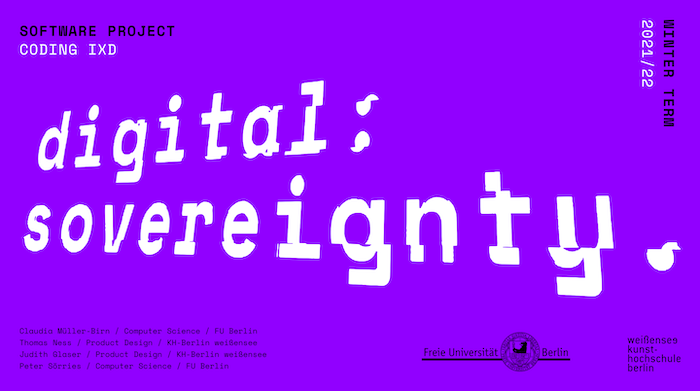Software Project: Coding IxD – Designing Neo-analogue Artifacts
(19319312)
| Type | Project |
|---|---|
| Instructor | Prof. Dr. Claudia Müller-Birn |
| Number of Places | 16 |
| Start | Oct 20, 2021 | 09:00 AM |
| end | Feb 16, 2022 | 12:00 PM |
| Time | Wednesday 9 am - 12 pm |
Links
- Lecture Catalogue FU Berlin (with Modul Assignments)
- Whiteboard - Internal Course Communication - Please Register
Student Profile
BSc. and MSc.
Software Project Website
Course Description
In this course, we co-educate computer scientists and product designers. Beyond experiencing interdisciplinary work, we want students to envision interactive systems that are intelligent: by this, we mean an intelligence through code that is carefully using material, form, and context, while profoundly respecting both human capabilities and vulnerabilities.
We understand this course as experimental space, where different perspectives meet, exchange, and evolve. Each semester, based on small project teams of up to five members, students are challenged to examine a specific application context. Within this context, the teams envision a new application or product concept.
We guide this process through various carefully tuned methods that are used to spark their ideas. Students iterate through several rounds of ideation and refine their concept in different prototype versions. The most compelling or promising interaction concept, the one that allows grasping the quality and essence of the product concept is implemented in a working prototype.
Students are accompanied by a team of experienced designers and computer scientists but also by guest experts that provide feedback to the various design iterations. If needed, special workshops are organized to cover specific topics ranging from prototyping to project management. The whole course is evaluated continuously to enhance our methodological toolbox.
This course offering is a cooperation of the Human-Centered Computing Research Group at the Institute of Computer Science at the Freie Universität Berlin and the Product Design Department at the Weißensee Kunsthochschule Berlin (KHB).
Besides the regular weekly meetings, the KHB provides complimentary workshops each Monday from 10 AM to 1 PM where participation for computer science students is optional.
The current topic can be found on the HCC research group website and on the course page.
Here you can find our Code of Conduct.
Topic: Superanus digital
"Recent inventions and business methods call attention to the next step which must be taken for the protection of the person, and for securing to the individual what Judge Cooley calls the right ‚to be let alone‘. Instantaneous photographs and newspaper enterprise have invaded the sacred precincts of private and domestic life; and numerous mechanical devices threaten to make good the prediction that ‚what is whispered in the closet shall be proclaimed from the house-tops’."
– Warren and Brandeis, 1890
Privacy was already considered more than 100 years ago and is now highly discussed in the context of increasing digitalization and the domination of a few global players. The connection between technology, people, and society runs through countless „user-friendly“ manifestations of our daily lives; for example, in the form of voice assistants that play your favorite song, simple „like“ buttons, or sophisticated algorithms that suggest new friends on social media.
In this context, privacy as a „living, continually changing thing, a fluid concept, dependent on socio-cultural factors“ (Koops and Leenes, 2006) relates to an (even more) abstract concept, namely digital sovereignty. Digital sovereignty describes the ability of an individual or a society to use digital services (e.g., cloud or payment services and digital media) in a self-determined manner. Self-determination encompasses both individual capabilities and material conditions, such as legal, political, and infrastructural issues. However, from an individual, societal, economic, or ecological perspective, questions arise regarding relevant capabilities and conditions, such as: How can we (help) shape digital sovereignty? How can we support people in assessing the data security of digital services? How can we make individual data sharing and use transparent? How can we design for privacy? How can we make surveillance visible? How can we obfuscate our traces?
In the project superanus digital, we intend to uncover, explore and reshape the socio-material aspects of digital sovereignty by designing novel neo-analogue artifacts. The goal is to give back to both individuals and society the „ability to influence something […] and its dynamics […], including the ability to check and correct for any deviation“ (Floridi, 2020). Furthermore, new forms of interaction between people, material, and code will emerge, enabling sovereign decision-making by allowing individuals to reflect on their digital practices critically. In interdisciplinary teams, students from Freie Universität Berlin and Weißensee Kunsthochschule Berlin, and in cooperation with the Cluster of Excellence Matters of Activity, explore the possibilities of self-determination and „self-ownership, especially over one’s own body, choices, and data“ (Floridi, 2020) through neo-analogue artifacts.
The course takes place in cooperation with the Weißensee Academy of Art Berlin. We meet every Wednesday in the laboratory of the Cluster of Excellence "Matters of Activity" at the Humboldt-Universität zu Berlin.
Address
Sophienstrasse 22a, 2.HH, 2nd floor, 10178 Berlin
www.matters-of-activity.de/en/
Literature
- Zimmerman, John, Jodi Forlizzi, and Shelley Evenson. "Research through design as a method for interaction design research in HCI." Proceedings of the SIGCHI conference on Human factors in computing systems. 2007.
- Pierce, James, et al. "Expanding and refining design and criticality in HCI." Proceedings of the 33rd Annual ACM Conference on Human Factors in Computing Systems. 2015.
- Anthony Dunne and Fiona Raby. 2013. Speculative Everything: Design, Fiction, and Social Dreaming. The MIT Press.

